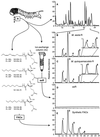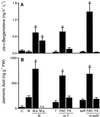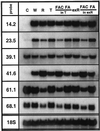Molecular interactions between the specialist herbivore Manduca sexta (Lepidoptera, Sphingidae) and its natural host Nicotiana attenuata. III. Fatty acid-amino acid conjugates in herbivore oral secretions are necessary and sufficient for herbivore-specific plant responses
- PMID: 11161028
- PMCID: PMC64872
- DOI: 10.1104/pp.125.2.711
Molecular interactions between the specialist herbivore Manduca sexta (Lepidoptera, Sphingidae) and its natural host Nicotiana attenuata. III. Fatty acid-amino acid conjugates in herbivore oral secretions are necessary and sufficient for herbivore-specific plant responses
Abstract
Feeding by the tobacco specialist Manduca sexta (Lepidoptera, Sphingidae) and application of larval oral secretions and regurgitant (R) to mechanical wounds are known to elicit: (a) a systemic release of mono- and sesquiterpenes, (b) a jasmonate burst, and (c) R-specific changes in transcript accumulation of putatively growth- and defense-related mRNAs in Nicotiana attenuata Torr. ex Wats. We identified several fatty acid-amino acid conjugates (FACs) in the R of M. sexta and the closely related species Manduca quinquemaculata which, when synthesized and applied to mechanical wounds at concentrations comparable with those found in R, elicited all three R-specific responses. Ion-exchange treatment of R, which removed all detectable FACs and free fatty acids (FAs), also removed all detectable activity. The biological activity of ion-exchanged R could be completely restored by the addition of synthetic FACs at R-equivalent concentrations, whereas the addition of FAs did not restore the biological activity of R. We conclude that the biological activity of R is not related to the supply of FAs to the octadecanoid cascade for endogenous jasmonate biosynthesis, but that FACs elicit the herbivore-specific responses by another mechanism and that the insect-produced modification of plant-derived FAs is necessary for the plant's recognition of this specialized herbivore.
Figures



References
-
- Alborn HT, Jones TH, Stenhagen GS, Tumlinson JH. Identification and synthesis of volicitin and related components from beet armyworm oral secretions. J Chem Ecol. 2000;26:203–220.
-
- Alborn HT, Turlings TCJ, Jones TH, Stenhagen G, Loughrin JH, Tumlinson JH. An elicitor of plant volatiles from beet armyworm oral secretion. Science. 1997;276:945–949.
-
- Baldwin IT. The alkaloidal responses of wild tobacco to real and simulated herbivory. Oecologia. 1988;77:378–381. - PubMed
-
- Baldwin IT. Inducible nicotine production in native Nicotiana as an example of adaptive phenotypic plasticity. J Chem Ecol. 1999;25:3–30.
-
- Baldwin IT, Schmelz EA. Constraints on an induced defense: the role of leaf area. Oecologia. 1994;97:424–430. - PubMed
Publication types
MeSH terms
Substances
Associated data
- Actions
- Actions
- Actions
- Actions
- Actions
- Actions
- Actions
LinkOut - more resources
Full Text Sources
Other Literature Sources
Research Materials
Miscellaneous

